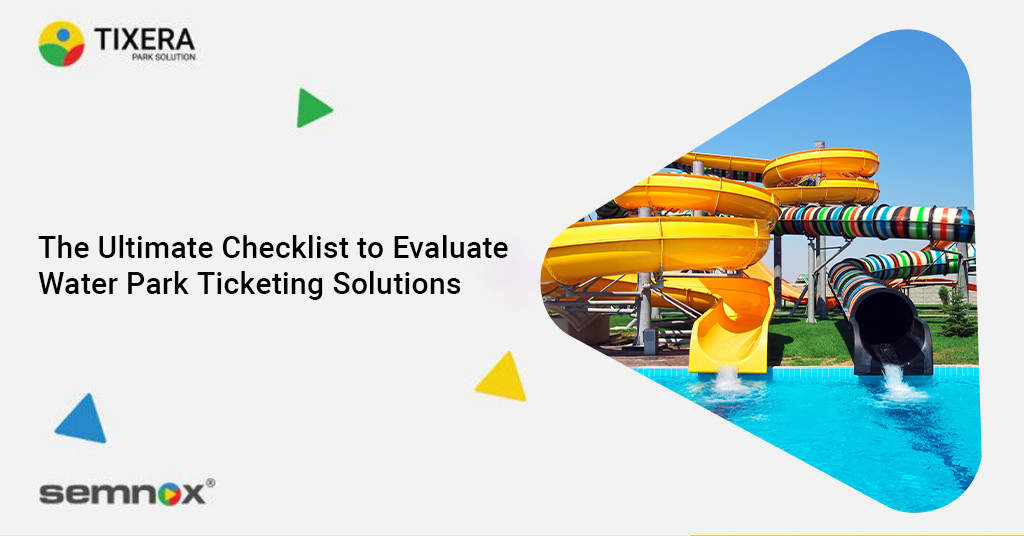
The Ultimate Checklist to Evaluate Water ParkTicketing Solutions
Introduction
At any water park, ticketing is the first and most important touchpoint in the guest experience. From online reservations to on-site entry, the right ticketing system can make or break your operations. It’s more than a point-of-sale. From the moment a visitor books online to the moment they walk through your gates, the ticketing system shapes how smooth, fast, and enjoyable that experience will be. Operators often struggle with long lines at entry, limited online booking options, poor data visibility, and ticketing platforms that do not integrate well with other systems like F&B, POS, or locker rentals. To help you choose the right water park ticketing system or upgrade your existing setup, we’ve created a clear, actionable checklist designed specifically for outdoor parks, attractions, and amusement venues.
1. Ticketing Flexibility
The ability to offer multiple ticket types is essential for appealing to different audiences and maximizing revenue. A flexible ticketing system for water park attractions should support everything from single-day admission to season passes and dynamic bundles. What to look for:
- Support for single-day, multi-day, group, and season passes
- Easy creation of promotions, flash sales, or bundled offers
- Flexible pricing tools for peak vs. off-peak days (dynamic pricing)
Pro Tip: Consider systems that allow for creative packages such as:
- Family combo passes with meals or locker rentals
- Afternoon-only access tickets
- Rainy-day raincheck passes or date-swappable tickets
The more customizable your pricing and pass structure, the easier it is to adjust for weather, crowd levels, or guest demographics.
2. Online and Mobile Booking
Your guests are online, and your ticketing system should meet them there. A frictionless mobile booking experience increases pre-arrival sales, reduces gate congestion, and enhances overall satisfaction. Key features:
- Mobile-optimized booking flow with intuitive navigation
- Multiple payment gateway integrations
- Add-ons and upgrades during checkout (lockers, cabanas, meals)
Why it matters: A mobile-first design means guests can book on the go, add experiences mid-checkout, and feel confident arriving with everything pre-planned.
3. Access Control and Entry Management
The guest journey should not stall at the front gate. Access control features built into your amusement park ticketing software help move guests through efficiently while protecting against misuse and fraud. Checklist items:
- RFID wristbands, barcodes, or QR code support for entry
- Real-time ticket validation with gate or handheld scanners
- Anti-pass back functionality to prevent ticket sharing
- Integration with lockers, cabanas, and cashless spending accounts
Smooth access control is key to reducing bottlenecks and ensuring guests feel welcomed and not delayed when they arrive.
4. Cashless Payments and In-Park Spending
Today’s guests want speed and convenience. A cashless-enabled water park ticketing system allows guests to spend without fumbling for wallets or worrying about wet bills. Look for:
- Reloadable RFID wristbands or cards tied to a guest account
- Ability to preload spending limits for kids or families
- Offline transaction mode for uninterrupted service during outages
- Contactless payment acceptance across food, retail, and rentals
- Enhanced Security with integration for apple and google payments
Why it matters: Faster payments mean shorter lines and higher per-capita spending. Plus, cashless systems improve hygiene and reduce cash-handling errors
5. Reporting and Analytics
Without data, you’re operating in the dark. A powerful ticketing system should deliver real-time insights to help you manage your waterpark and spot trends before they affect your bottom line. Evaluate:
- Live dashboards for ticket sales, attendance, and spending
- Reporting on revenue per guest and zone-level activity
- Attendance trends by time, day, weather, or ticket type
- Integration with accounting software for reconciliation and audit trails
Tip: Customizable reports allow you to pull the exact data you need for operations, finance, and marketing without digging through spreadsheets.
6. Integrations and Ecosystem
No software should operate in isolation. The best waterpark and amusement park ticketing software integrates easily with the rest of your tools. Questions to ask:
- Can it integrate with OTAs, POS, CRM, F&B systems, and gate controls?
- Is there an open API or app marketplace for added flexibility?
- Does it support third-party tools like waiver systems, loyalty programs, and marketing automation?
Seamless integration ensures your team avoids data silos, duplicate entry, and disconnected guest experiences.
7. Scalability and Multi-location Support
As your business grows, your software should grow with you. Whether you’re operating one park or expanding into a regional chain, scalability is essential. Consider:
- Ability to manage high-traffic days without slowing down
- Support for multiple parks, attractions, or event types
- Centralized dashboards to manage pricing, promotions, and reporting across locations
If you’re planning to expand or diversify offerings, your ticketing platform needs to scale without major infrastructure changes.
8. Ease of Use and Staff Training
Every minute spent training seasonal staff is a minute not spent serving guests. A user-friendly platform shortens the learning curve and reduces operational errors. Must-haves:
- Simple, intuitive interface for front-line staff
- Minimal onboarding required, even for seasonal hires
- Multi-language support for international guests and staff
Why it matters: A clean, consistent UI improves staff productivity and ensures guests receive accurate, speedy service.
9. Support, Security, and Compliance
Even the best systems need support. Your provider should have a strong service infrastructure and robust compliance policies. Ensure:
- 24/7 technical support with responsive SLAs
- Regular remote software updates and proactive system monitoring
- PCI compliance, encrypted payment processing, and data security protocols
The right partner helps you stay secure, compliant, and ahead of potential downtime or data breaches.
10. Self-Service Systems (Kiosks, Waivers, and F&B Ordering)
Self-service technology empowers guests while reducing pressure on staff. Your water park ticketing system should extend to kiosks and unattended touchpoints. Look for:
- Self-service kiosks for ticketing and guest check-in
- Integrated digital waiver signing stations
- In-park F&B ordering kiosks with upsell options
- Touchless upgrades and autonomous check-ins
Why it works: These tools increase guest autonomy, reduce staffing costs, and open new revenue streams through well-placed upsells.
Bonus: Future-Ready Features
Don’t just solve today’s problems, plan for tomorrow’s opportunities. Choose a system that is adaptable, upgradable, and ready for emerging guest expectations. Future-proof features to consider:
- Dynamic pricing tools with real-time adjustments
- Mobile self-service check-in and booking enhancements
- Built-in upsell prompts based on guest behavior
- Real-time guest feedback collection and sentiment tracking
The best systems innovate alongside you, not behind you. Conclusion The right amusement park ticketing software can do more than just sell tickets. It can increase revenue, reduce operational headaches, and transform your entire guest experience. Use this checklist as a guide when evaluating your current system or exploring new solutions. Want to see how Tixera by Semnox stacks up against this checklist?
FAQs
1.What features should I look for in a water park ticketing solution?
Look for essential features like contactless ticketing, mobile support, real-time analytics, integrated POS, dynamic pricing, and RFID capabilities.
2. How does a cloud-based ticketing system benefit water parks?
A cloud-based system offers remote access, automatic updates, scalability, and seamless data backup—ideal for growing water parks.
3. Can water park ticketing software integrate with turnstiles and kiosks?
Yes, leading systems like Tixera offer seamless integration with entry turnstiles, self-service kiosks, and access control devices.
4. Is RFID technology important in modern water park ticketing systems?
Absolutely. RFID technology allows for cashless payments, locker access, and faster entry—improving both operations and guest convenience.
5. How do I choose the right ticketing vendor for my water park?
Use a comprehensive evaluation checklist that covers scalability, uptime, integrations, support, data security, and guest experience features.
With a deep-rooted understanding of the attractions and leisure industry, Ashish K S stands out as a strategic leader driving innovation and operational efficiency in large-scale ticketing environments. Backed by years of expertise in enterprise-level implementations and cross-functional leadership, Ashish has become a cornerstone of Semnox’s success in the domain.
At Tixera, Semnox’s specialized ticketing and visitor management solution, Ashish leads the charge in transforming how amusement parks, waterparks, and museums manage guests—from the first click to the final exit. His focus on scalable technology, seamless integrations, and customer-first development has empowered venues across the globe to enhance guest experiences while optimizing operations..

